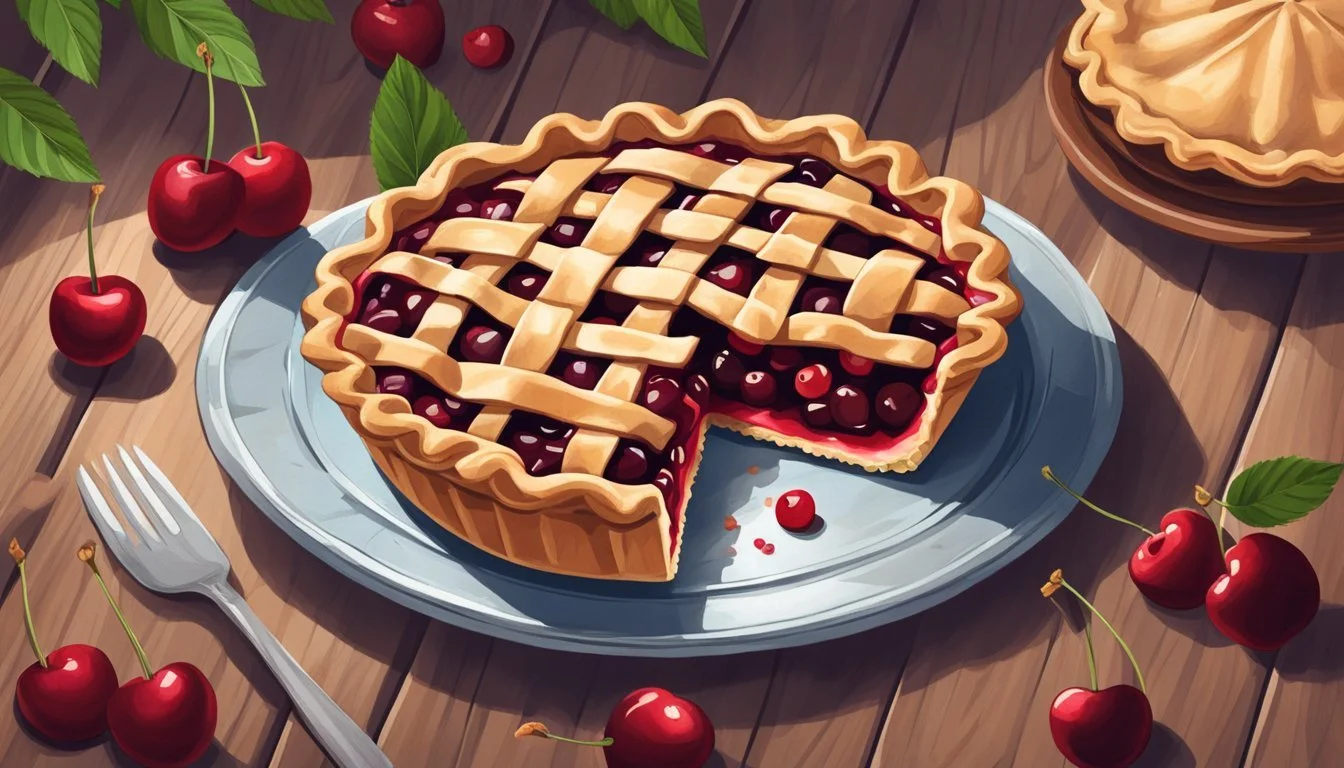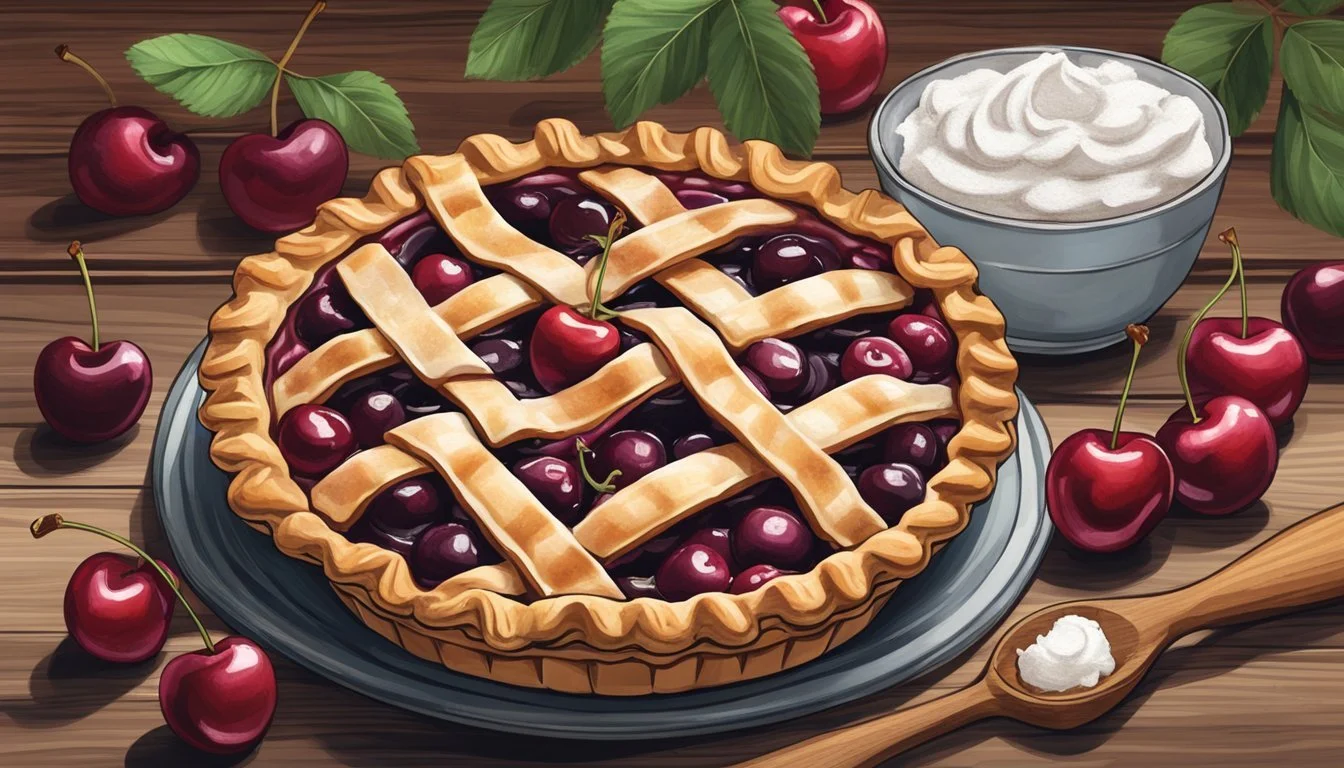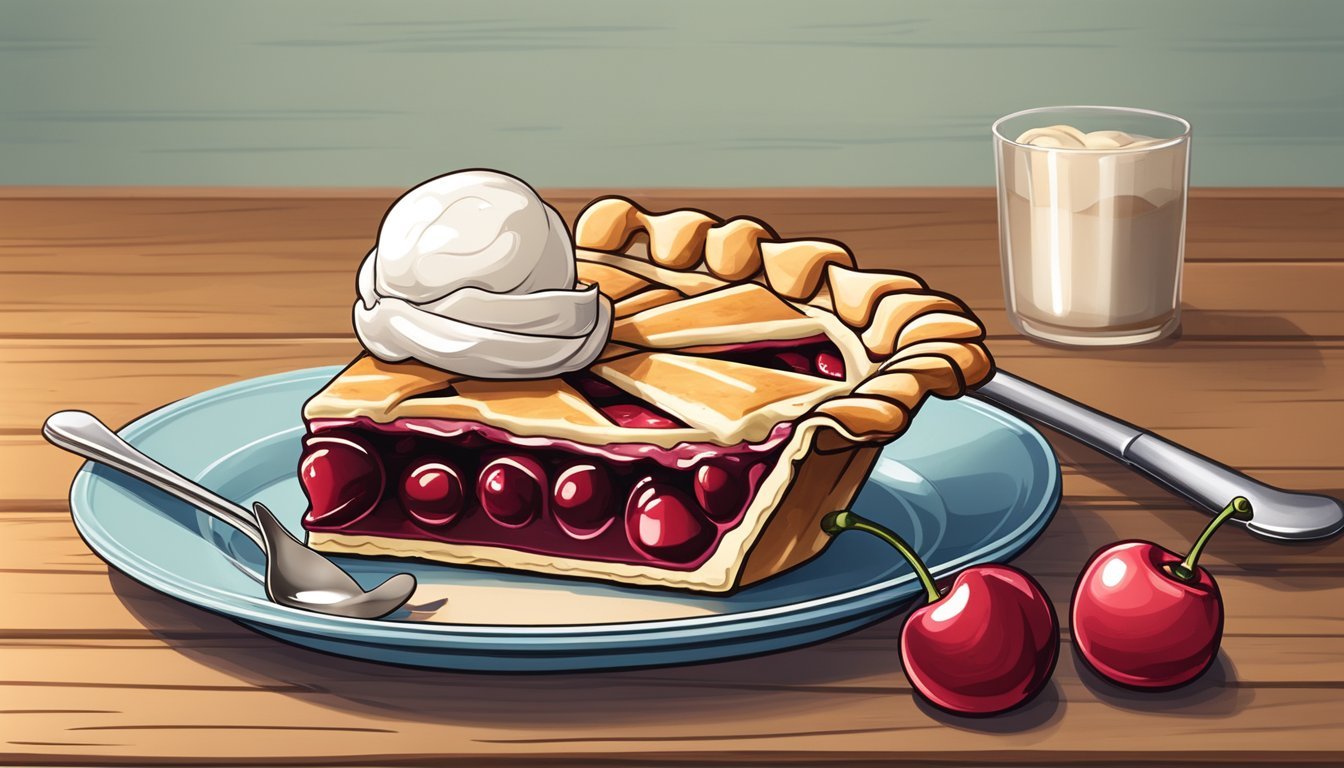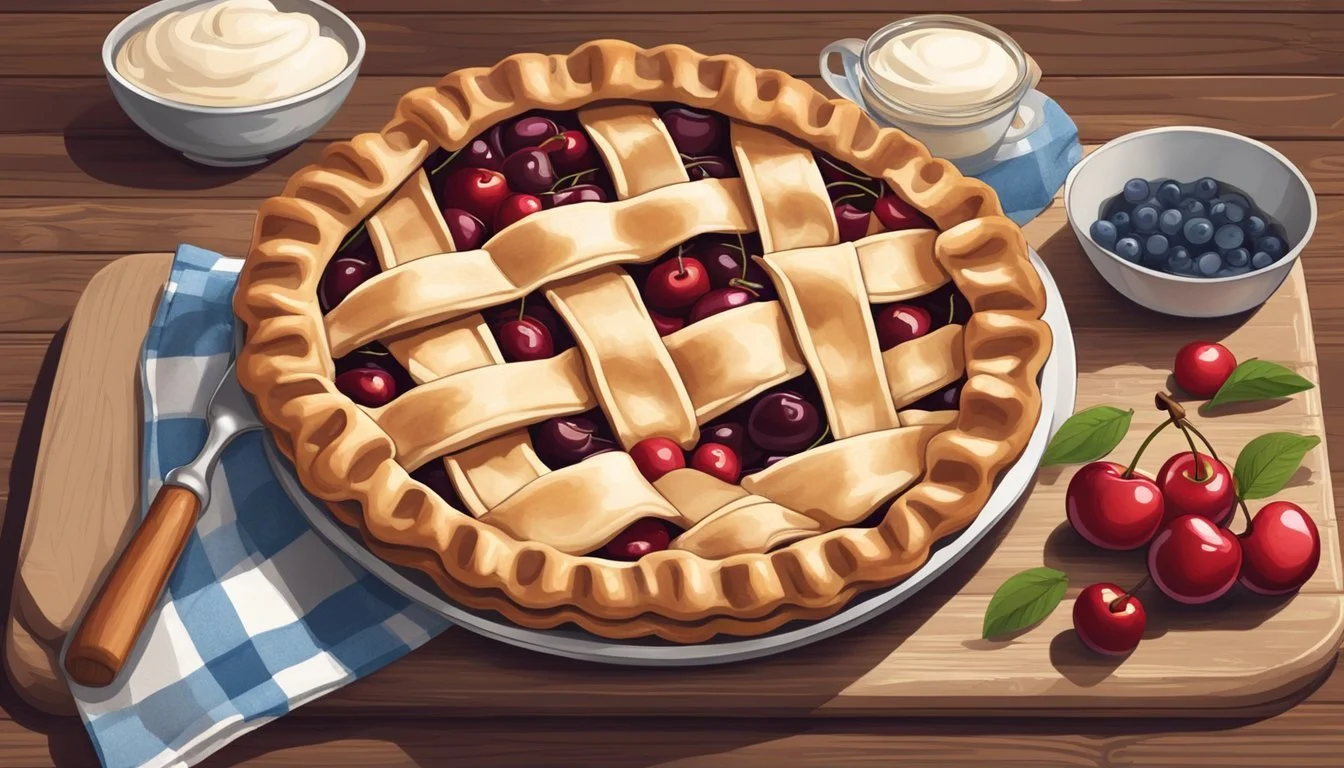Is Cherry Pie Vegan?
Understanding the Ingredients and Options
Cherry pie is a beloved dessert known for its vibrant filling and flaky crust. While traditional recipes include ingredients like butter and lard, a growing demand for plant-based alternatives has paved the way for vegan cherry pies. These vegan options replace dairy and other animal products with plant-based ingredients without compromising the classic taste and texture that cherry pie enthusiasts appreciate.
Vegan cherry pies are made using a variety of substitutes ensuring that the pie is free from animal-derived products. The crust can be prepared using plant-based fats such as vegan butter, coconut oil, or vegetable shortening, while the filling typically consists of cherries, sugar, and a thickening agent like tapioca flour or cornstarch. Flavor enhancers such as lemon juice, almond extract, and vanilla extract are also often added to enrich the pie’s taste.
It’s important to note that not all cherry pies are inherently vegan, and those looking for vegan options should check labels when buying ready-made pies or carefully select recipes if making the dessert at home. The availability of vegan cherry pies has increased along with recipes catering to the vegan diet, enabling everyone to enjoy this classic dessert regardless of dietary preferences.
Understanding Veganism
This section outlines the essence of veganism, its dietary restrictions, and nutrition, particularly as they relate to vegan desserts like cherry pie.
Definition and Principles
Veganism is a lifestyle choice that excludes all forms of animal exploitation and cruelty, whether for food, clothing, or any other purpose. Its dietary aspect involves abstaining from animal products such as meat, dairy, and eggs. Vegans aim to consume foods derived entirely from plants.
Common Non-Vegan Ingredients
In traditional dessert recipes, including cherry pie, common non-vegan ingredients are often found. Here is a list of such ingredients and their vegan alternatives:
Butter: Often used in pie crust, replaced by plant-based margarine or oils.
Milk: Dairy milk can be substituted with almond, soy, or oat milk.
Eggs: Used as a binding agent, replaced with flaxseeds, chia seeds, or commercial egg replacers.
Non-Vegan Ingredient Vegan Alternative Butter Plant-based margarine Milk Soy/Almond/Oat milk Eggs Flax or chia seeds
Health and Nutrition Facts
Vegan desserts can be beneficial for those looking to consume fewer calories and saturated fats. Let's examine the nutritional components relevant to a vegan cherry pie:
Calories: Typically lower in vegan versions due to plant-based ingredients.
Carbohydrates: The primary energy source, essential for the body's functions.
Protein: Plant-based pies might have less protein, but can be optimized with the right ingredients.
Fat: Vegan pies often have less saturated fat due to the absence of butter and milk.
Fiber: Generally higher in vegan desserts due to the use of whole fruits and grains.
Potassium, Calcium, Iron: These nutrients vary depending on the ingredients used, with plant-based sources capable of providing adequate amounts.
Nutritional content in vegan cherry pie (per serving):
Nutrient Amount Calories 280-350 Carbohydrates 45-60g Protein 3-5g Fat 10-15g Saturated Fat 0-2g Sodium 200-300mg Fiber 3-5g Potassium 100-200mg Calcium 20-50mg Iron 1-2mg
Vegan desserts are diverse and can belong to any cuisine or course, matching the flavors and textures of non-vegan equivalents. The goal is to create delicious options without animal-derived ingredients, making them suitable for vegans and those with dairy allergies.
Essentials of Vegan Cherry Pie
Creating a delicious vegan cherry pie requires attention to detail in the selection of animal-free ingredients, ensuring the final product delivers a sweet and tart flavor with a golden brown, flaky crust.
Key Ingredients for Vegan Cherry Pie
Pie Crust:
Flour: The base for any pie crust, with the option to choose gluten-free varieties.
Fat: Vegan butter or oil to make the crust rich and flaky.
Water: Ice-cold water to bring the dough together.
Cherry Filling:
Cherries: Both fresh and frozen cherries are suitable. Sour cherries bring tartness, while sweet cherries add natural sweetness.
Sweetener: Organic sugar is preferred for sweetness.
Thickener: Cornstarch or arrowroot to solidify the filling.
Flavor Enhancers: Lemon juice and vanilla extract accentuate the cherries' flavor.
Creating the Perfect Vegan Pie Crust
Ingredients:
2 1/2 cups flour
1 cup vegan butter, chilled and cubed
1/2 teaspoon salt
4-6 tablespoons ice water
Instructions:
Combine flour and salt.
Cut in the vegan butter until the mixture resembles coarse crumbs.
Gradually add ice water until the dough forms.
Divide dough, roll out one piece for the bottom crust, and set another aside for a lattice top, if desired.
Bake at 180°C/356°F with baking beans for 10 minutes for pre-baking.
Cherry Filling Variations
A vegan cherry pie filling can be tailored to personal taste preferences. One can use:
Sour Cherries: For a more tart profile.
Sweet Cherries: To enhance sweetness.
Combination: A mix of both to balance the flavors.
For a twist on the traditional, one might add:
Spices: Such as cinnamon or nutmeg.
Zest: Orange or lemon zest for a citrus note.
Extracts: Almond or additional vanilla extract for depth.
Overall, the essentials of making a vegan cherry pie involve choosing the right plant-based ingredients to achieve a balance of sweet and tart flavors encased in a golden, flaky crust. The filling can be adjusted according to the available cherry types and desired sweetness level.
Step-by-Step Baking Guide
Creating a vegan cherry pie involves careful preparation and accurate baking techniques. By following a clear set of instructions, one can produce an easy-to-make dessert that is sure to delight the palate.
Preparation Techniques
To begin, they must gather all the necessary ingredients required for the vegan pie crust and cherry filling. They will need a rolling pin to roll out the dough to the desired thickness. A typical crust requires rolling to a 1/4 inch thickness for optimal baking results. For those aiming for a lattice crust, extra dough is needed to create the weaved top layer.
Crust Preparation
Roll one disk of dough into a circle, approximately 1/4 inch thick.
Transfer the rolled dough into the pie dish, pressing it firmly against the bottom and sides.
Filling Preparation
In a bowl, combine cherries, sweetener, and thickener, adding flavorings such as lemon zest and almond extract.
Evenly distribute the cherry mixture into the prepared pie crust.
Baking Instructions
Preheat the oven to the temperature specified by the recipe, commonly around 425°F for initial baking. The pie should be placed in the oven to cook for the time required to achieve a golden-brown crust and bubbling filling.
Pre-Baking (optional)
Cover the bottom crust with baking paper.
Add baking beans to prevent the crust from rising.
Pre-bake for 10 minutes, then remove beans and paper.
Baking
Cook time generally ranges from 35 to 45 minutes.
They should keep an eye on the pie to ensure the crust doesn't overcook.
Tip: The total time, including both prep time and cook time, can be up to an hour or more, depending on the specific recipe and whether they choose to pre-bake the crust.
By maintaining attention to detail throughout the preparation and baking phases, one will find that making a homemade vegan cherry pie is a rewarding process that yields delicious results.
Texture and Flavor Enhancements
When perfecting a vegan cherry pie, maintaining balance between sweetness and texture is key, as is achieving that enticing golden brown crust indicative of a well-baked pie.
Sweetness and Spice Adjustments
Adjusting the sweetness of a cherry pie filling is crucial for achieving the perfect balance of sweet and tart flavors. One can experiment with different sweeteners such as granulated sugar or organic cane sugar. For enhanced flavor, the addition of spices like cinnamon can add a warm complexity to the pie, while a hint of almond extract can provide a subtle, nutty undertone.
Sweeteners:
Granulated sugar
Organic cane sugar
Flavor enhancers:
Cinnamon (a pinch)
Almond extract (½ teaspoon)
Achieving a Golden Brown Crust
The crust contributes significantly to the overall eating experience of a cherry pie. To attain a flavorful and golden brown crust, one might consider applying a vegan egg wash prior to baking. This wash can help in browning and giving the crust a pleasing sheen. Additionally, monitoring the oven temperature and baking time is essential to prevent burning and ensure that the crust develops properly.
Crust browning techniques:
Vegan egg wash application
Precise baking time control
To ensure your crust is golden brown and not overly dark, bake at a recommended temperature – frequently 375°F (190°C) – and start checking for doneness a few minutes before the suggested baking time concludes.
Complementary Pairings
When serving a vegan cherry pie, the right accompaniments can elevate the dessert experience. From pairing with the perfect drink to selecting a complementary topping, each choice enhances the flavors and textures of the pie.
Serving Suggestions
A classic serving suggestion for vegan cherry pie is a scoop of vegan vanilla ice cream; its creamy texture and subtle flavor contrast beautifully with the pie’s fruit-filled charm. For a lighter alternative, a dollop of vegan whipped cream can add a luxurious finish without overpowering the dessert. Another versatile topping is a drizzle of vanilla extract, which intensifies the pie’s aroma and adds a hint of sophistication.
Top Toppings:
Vegan Vanilla Ice Cream
Vegan Whipped Cream
A Drizzle of Vanilla Extract
Drinks to Accompany
The beverages chosen to accompany vegan cherry pie should complement its rich and fruity profile. For a harmonious pairing, opt for a beverage that balances sweetness with acidity.
Beverage Pairings:
Tea: A warm cup of black tea can enhance the flavors with its tannic notes.
Coffee: Coffee offers a bittersweet counterpoint that works well with the sweetness of the pie.
Dessert Wine: For those who enjoy alcohol, a sweet dessert wine can be a delightful match.
When selecting servings and beverages, consider these pairings to ensure each bite of vegan cherry pie is as satisfying as the last.
Adaptations for Special Diets
Cherry pie can be adapted for various dietary needs by modifying the crust and filling ingredients. By selecting the right substitutes, individuals can enjoy this dessert while adhering to gluten-free or allergy-friendly diets.
Gluten-Free Options
For those requiring a gluten-free diet, the traditional wheat flour in pie crusts can be easily replaced with a gluten-free flour blend. Almond or coconut flour can be utilized as well, offering a nutritious alternative rich in polyunsaturated fats.
Gluten-Free Flour Blends: A 1:1 replacement for all-purpose flour.
Almond/Coconut Flour: May require additional binders, like xanthan gum, due to their denser nature.
Allergy-Friendly Substitutes
Allergy-friendly adaptations focus on replacing common allergens such as dairy or eggs. Vegan butter and plant-based milk serve as safe substitutes for dairy, and flaxseeds or chia seeds soaked in water can replace eggs.
Vegan Butter: Free from trans fat and often based on soy or other plant oils.
Plant-Based Milk: Soy, almond, or oat milk can be used in place of cow's milk.
Egg Replacers: Flax or chia "eggs" (1 tablespoon of ground seeds with 3 tablespoons of water equates to one egg).
By incorporating these substitutions, cherry pie can be enjoyed by those with specific dietary restrictions, ensuring both inclusivity and enjoyment in every slice.
Storage and Preservation
Proper storage techniques ensure the longevity and quality of cherry pies, a treasured sweet and fruity dessert.
Refrigerating and Freezing Tips
Refrigerating: A cherry pie can be stored in the fridge to maintain its freshness. Place the cooled pie in an airtight container or wrap it tightly with plastic wrap to prevent it from absorbing odors from the fridge. Typically, a cherry pie can last up to 4 days when refrigerated.
Container: Airtight container
Wrap: Plastic wrap or aluminum foil
Duration: Up to 4 days
Freezing: For longer storage, freezing a cherry pie is an option. First, allow the pie to cool completely. Then, wrap the pie securely in plastic wrap followed by a layer of aluminum foil. It's best to place the wrapped pie in a heavy-duty freezer bag to protect from freezer burn. Properly stored, a cherry pie can be frozen for up to 3 months.
Preparation: Cool completely, wrap well
Materials: Plastic wrap, aluminum foil, freezer bag
Duration: Up to 3 months
Maximizing Freshness of Leftovers
To keep leftover cherry pie tasting as delightful as when it was first baked, wrapping the pie thoroughly is crucial. Cover the pie with plastic wrap or place it in a covered pie carrier for added protection. This helps to retain moisture and flavor in the fruit pie. It's vital to limit the exposure to air, which accelerates the staling process. The more airtight the storage, the better the pie will keep.
Holiday and Seasonal Variations
Given the versatility of cherry pie, it can easily be adapted into vegan versions to suit seasonal festivities and the abundance of summer's harvest. With careful ingredient selection, vegan cherry pie becomes a celebration of both taste and tradition.
Summertime Cherry Delights
During the summer, fresh cherries are in abundance, making it the perfect time to bake a vegan cherry pie. The bright, tangy flavor of freshly picked cherries enhances the natural sweetness of the pie. In summer, one might opt for a lighter, fruit-focused dessert, capitalizing on the season's bounty:
Ingredients: Fresh cherries, vegan crust, sugar substitute, thickener (e.g., tapioca flour)
Preparation: Use fresh pitted cherries, and keep the filling simple to let the fruit's flavor shine.
Festive Vegan Treats
The holidays call for an array of vegan pies, from the traditional vegan cherry pie to seasonal favorites like vegan pumpkin pie and vegan apple pie. Each pie can be decorated with festive designs, such as a lattice crust or leaf-shaped pastry cutouts. For holiday gatherings, individuals often showcase an assortment of fruit pies, embracing the festive spirit:
Vegan Cherry Pie: A classic choice, often adorned with a decorative lattice top.
Vegan Pumpkin Pie: Rich and spiced, a staple at many holiday tables.
Vegan Apple Pie: Sweet and warmly spiced, it’s a comforting end to any festive meal.
These pies substitute dairy and animal-derived ingredients with plant-based alternatives, like non-dairy butter and egg-free pastry, ensuring that the holiday spirit is inclusive and delightful for everyone.
Troubleshooting Common Baking Issues
When baking cherry pie, bakers may face several common issues that can affect the final outcome of their vegan pie. Identifying and rectifying these challenges is crucial for a successful bake.
Problem: Soggy Bottom
Solution: Ensure the pie dish is heated beforehand. Pre-baking the crust with baking paper and baking beans can partially cook the crust preventing sogginess. The pie crust should be rolled evenly to avoid thin areas that may become too wet.
Problem: Cracked Crust
Solution: If a pie crust cracks, a little cold water can be used to mend it. The water acts as a glue, binding the crust back together. Handling the dough with care will prevent cracks from developing.
Crust Preparation:
Ingredient Purpose Flour Provides structure Fat (vegan butter/coconut oil) Adds flakiness Ice Water Binds ingredients without activating gluten
Problem: Filling Overflowing
Solution: To prevent this, avoid overfilling the crust with cherry filling. Leave a small margin at the top to accommodate the filling as it expands while baking. Using a double pie crust can also help contain the cherries better.
Problem: Uneven Baking
Solution: Rotate the pie dish halfway through baking to ensure even cooking. Check that the oven is preheated correctly and that the pie is placed on the middle rack for optimal heat distribution.
These solutions should be approached with confidence, keeping the instructions clear, and applying a neutral tone to ensure that they can be implemented by all bakers regardless of experience level.
Tools and Equipment
When baking a cherry pie, certain tools and equipment are indispensable to achieve the perfect texture and flavor. Precision in measurements and technique is key in dessert making, particularly for creating an impeccable pie crust.
Essential Baking Utensils
Pie Dish: A pie dish is fundamental for shaping and baking your cherry pie. It should be deep enough to hold the cherry filling and crust.
Rolling Pin: To achieve an even thickness of the pie crust, a rolling pin is essential. A smooth, non-stick pin is preferable.
Cherry Pitter: While optional, a cherry pitter can expedite the process of preparing fresh cherries by removing pits efficiently and cleanly.
Measuring Tools: Accurate measurements are crucial. Measuring cups and spoons are required for precise ingredient ratios.
Mixing Bowls: Various sizes of mixing bowls are needed for preparing the crust and filling separately.
Baking Paper: Lining the bottom of your pie with baking paper helps in even baking and easy removal.
Baking Beans/Substitutes: Dry beans, rice, or commercial pie weights are needed to blind bake the crust and prevent it from puffing up.
Kitchen Scales: For those who prefer weight measurements, a kitchen scale ensures accuracy, especially for the flour measurement.
Knife: A sharp knife is necessary to trim excess dough from the edges of the pie dish.
Basting Brush: A brush is required for applying washes on the crust which can give a golden and shiny finish.
Food Processor: Optional but helpful in creating a consistent pie dough when cutting butter into flour.
Baking Utensil Purpose Pie Dish Shape and bake pie Rolling Pin Even out pie dough Cherry Pitter Remove pits from fresh cherries Measuring Tools Measure ingredients Mixing Bowls Prepare crust and filling Baking Paper Line pie dish Baking Beans Blind bake pie crust Kitchen Scales Accurate ingredient measurements Knife Trim dough Basting Brush Apply washes for crust finish Food Processor Combine dough ingredients consistently
Alternative Tools for Preparation
In the absence of professional baking utensils, one can use readily available household items as substitutes. A wine bottle can function as a makeshift rolling pin, while aluminum foil paired with dry goods can replace baking paper or beans. For pitting cherries, one can also use a metal straw or a chopstick to push out the pits.
Tablespoons can serve as a last resort for measuring small quantities of ingredients if measuring spoons are not available. One tablespoon is typically equivalent to three teaspoons, and this conversion can be used to approximate smaller measurements.
A hand mixer or a simple whisk can substitute for a food processor when making dough, although this may require extra manual effort to attain the same consistency.
Substitute Tool Replacement for Notes Wine Bottle Rolling Pin Wrap in plastic for smoother rolling Aluminum Foil Baking Paper Use with dry goods for pie weight Metal Straw/Chopstick Cherry Pitter Push pits out from cherries Tablespoons Measuring Tools Imperfect but can estimate measurements Hand Mixer/Whisk Food Processor Mix dough manually
Utilizing the proper tools and being aware of potential substitutes is beneficial for bakers, ensuring no interruption in the preparation process.
Nutritional Information Breakdown
When assessing the nutritional profile of cherry pie, especially vegan varieties, it is important to consider the caloric and macronutrient content along with the presence of essential vitamins and minerals.
Caloric and Macronutrient Content
Vegan cherry pies typically derive their calories from three macronutrients: carbohydrates, proteins, and fats. The average slice of vegan cherry pie can contain approximately:
Calories: 250-400 kcal
Carbohydrates: 40-60g
Proteins: 2-4g
Fat: 10-20g
Saturated Fat: 3-8g
These ranges can vary based on the recipe ingredients and serving sizes. It's common for the crust to add a significant amount of fat, particularly if made with plant-based butter or oils.
Vitamins and Minerals
Vegan cherry pie contains several important vitamins and minerals. Here's a brief overview:
Vitamin A: Important for eye health and commonly found in the cherries themselves.
Vitamin C: An antioxidant present in cherries that supports the immune system.
Potassium: Critical for heart function and muscle contractions, cherries are a good source.
Calcium: Can be found in fortified plant-based ingredients used.
Iron: Present in whole grains that may be used in the pie crust.
While the exact amounts of these nutrients can vary, cherries are naturally rich in vitamins and minerals, contributing to the overall nutritional value of the pie.
The Cultural Significance of Cherry Pie
Cherry pie is an iconic dessert in American culture, often associated with tradition, comfort, and nostalgia. This classic cherry pie, with its bright red filling and golden crust, has been a staple at many family gatherings, holiday celebrations, and community events. Its popularity peaks around the Fourth of July and Thanksgiving, making it more than a mere sweet treat; it's a symbol of festivity and Americana.
Ingredients Found in Traditional Cherry Pie:
Cherries: The star of the pie, usually tart varieties.
Sugar: To balance the tartness of the cherries.
Thickening agents: Such as cornstarch or flour.
Pie crust: Flaky and buttery, typically made from shortening or butter.
Beyond its status as a delightful snack, cherry pie signifies the simplicity and wholesomeness of bygone eras. Bakers across the country have cherished and passed down cherry pie recipes, often with personal or regional twists that contribute to its rich tapestry of variations.
Factors That Influence Cherry Pie Variations:
Local Cherries: The type of cherry can vary by region, influencing the pie's flavor and texture.
Crust Design: Variations from a classic double crust to a decorative lattice top.
Serving Style: Served warm or cold, sometimes alongside ice cream or whipped cream.
Despite these regional variations, the essence of cherry pie remains rooted in the shared experience of enjoying a beloved cherry dessert. Through its continued presence at social functions and its representation in media and literature, cherry pie has cemented its role as a culinary emblem within the cultural fabric of American society.










